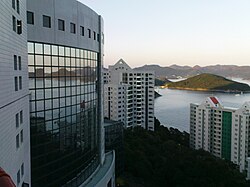Hong Kong University of Science and Technology Library
| Hong Kong University of Science and Technology Library | |
|---|---|
| 香港科技大學圖書館 | |
 | |
 | |
| 22°20′15″N 114°15′47″E / 22.3375°N 114.263°E | |
| Location | Clear Water Bay, the New Territories, Hong Kong |
| Type | Academic Library |
| Established | 1991 |
| Collection | |
| Size |
|
| Other information | |
| Website | library |
The Hong Kong University of Science and Technology Library is housed in the Lee Shau Kee Library, located at the Hong Kong University of Science and Technology. It has over 1 million books, 728,426 printed volumes, 754,146 in electronic format, as well as tens of thousands of e-journals, and streaming audio and video collections.[1] A good part of its special collections, like its Antique Maps of China Collection has been digitized.
Opening its doors in 1991, David Wilson, Baron Wilson of Tillyorn who was the Governor of Hong Kong at the time, was impressed by the fact that the Library had an advanced bilingual Chinese and English online catalog.[2] The Library continued to be a pioneer in library and information services, rolling out the first large-scale campus-wide CD-ROM network in Asian academic libraries; and in 1993 an early Course Reserve Image system. In 1995, its CD-ROM juke-box was the largest such installation outside of the USA[3] and it also had launched the first academic Library Web Server in Hong Kong in 1995 as well.[4] In its first 10 years, it became a mirror site for some subscription databases, and implemented wide-scale XML-based database projects and other innovations.[5]
Joining the Scholarly Publishing and Academic Research Coalition (SPARC) in 1999[6] it has also been a long-time promoter of open access. It launched the first Institutional Repository in Hong Kong in 2003 and members of the library's Reference team worked to promote it among faculty members.[7][8]
From 2011 through 2012 the Library built an extension of 1,800 square meters and renovated an existing 1,800 sq.m. into a Learning Commons. The HKUST Learning Commons provides ~600 seats and has 5 zones: Group Study, Open Study, Refreshment, Teaching, and The Creative Media Zone.[9]
The Library and its staff were very active in supporting the university in the University Grants Committee (Hong Kong)'s Hong Kong Research Assessment Exercise of 2014.[10] In 2014, it launched the first WhatsApp service in Hong Kong academic library.[11]
HKUST Library is an active member of the Joint University Librarians Advisory Committee, which is a consortium of the libraries of the eight universities funded by the University Grants Committee. In 2014, years of coordination and work bore fruit when a new Hong Kong JULAC Common Library Card was launched.[12] 2014 also saw the launch of the large system-wide JULAC Shared ILS Project, which officially lasted from May 2014 through July 2017. The front-end of the new ILS at HKUST is called PowerSearch. HKUST Library systems staff have worked to use the capabilities of both Alma and Primo to create "Knowledge Cards", which enhance discovery via bibliographic linked data [13]
HKUST Library is proactive and innovative in its staff training and development [14] and developing leadership [15]
The Library now has a Dataverse based research data repository and management service known as DataSpace@HKUST.[16]
References
- ^ Library Statistics: Collection retrieved from https://library.ust.hk/about-us/statistics/at-a-glance/
- ^ Beck, Catherine. (11 October 1991). Newest college ready for business. The South China Morning Post, p. 3
- ^ Chau, Mimi (11 May 1995). Library switches on the CD-ROM `Jukebox'. The South China Morning Post, retrieved from Factiva May 22, 2015.
- ^ Spodick, E. and Lam, K.T. (2005) Enhancing services in a digital age – 10 years of experience from the systems librarians' perspective, Lecture Notes in Computer Science, v. 3815, 2005, p. 370
- ^ ibid
- ^ Albanese, A. (1999). Academic Libraries. Library Journal, 124(18), 22
- ^ Chan, D. H., Kwok, C. Y., & Yip, S. F. (2005). Changing roles of reference librarians: the case of the HKUST Institutional Repository. Reference Services Review, 33(3), 268–282. doi:10.1108/00907320510611302
- ^ Information repositories arrive in Asia Archived 2016-03-05 at the Wayback Machine (December, 2004). Access, no. 51
- ^ Chan, DLH and Spodick, E. (2014). Space development: a case study of HKUST Library. New Library World, v. 115, (5/6), 2014, p. 250-262 http://hdl.handle.net/1783.1/61183
- ^ Wong, GKW, Caplan, VF, Chan DLH, Fung, LMY, Lam, KT (2015) Actively demonstrating library expertise in a research assessment exercise, Library Management, v. 36 p. 115-126 http://hdl.handle.net/1783.1/64398
- ^ Caplan, V, Lam, K.T.(2014).WhatsApp at HKUST library: a new channel for user communication. Presentation at The 5th International m-libraries Conference, Hong Kong, China, 28-29 May 2014. http://hdl.handle.net/1783.1/60811
- ^ Mak, Yee Man Venia; Chan, Diana L.H.; Lam, Ki Tat; Li, Y.O.Hong Kong JULAC common library card Library Management, v. 36, (8/9), 2015, p. 690-700. http://hdl.handle.net/1783.1/74935
- ^ Lam, Ki Tat.(2019). Implementing Knowledge Card to enhance information discovery through bibliographic linked data. Symposium on Linked Data and the Semantic Web, Hong Kong, 4 March 2019. http://hdl.handle.net/1783.1/74935
- ^ Chan, D.L.H. Using Formal and Informal Channels to Update Librarians’ Skill Set. In Baker, David, Evans, Wendy (Eds.) The End of Wisdom. Chandos Publishing, 2017, Ch. 7, pp 75-81. https://doi.org/10.1016/B978-0-08-100142-4.00007-5
- ^ Wong, G. and Chan, D. (2018), "Adaptive leadership in academic libraries", Library Management, Vol. 39 No. 1/2, pp. 106-115. https://doi.org/10.1108/LM-06-2017-0060
- ^ "DataSpace@HKUST – research data repository and management service – HKUST Library Blog". Retrieved 2020-06-29.
